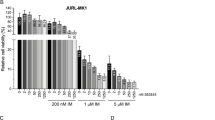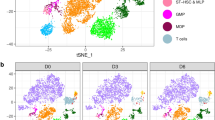Abstract
The intercellular communication between leukemia cells and bone marrow mesenchymal stem cells (BM-MSCs) plays more important role in chronic myeloid leukemia (CML) than we previously understood. Recently, we found that microvesicles released from human leukemia cell line K562 (K562-MVs) containing BCR-ABL1 mRNA malignantly transformed normal hematopoietic transplants. Here, we investigated whether K562-MVs contribute to the transformation of human bone marrow mesenchymal stem cells (BM-MSCs). We showed that K562-MVs could be integrated into co-cultured normal BM-MSCs and dose-dependently enhanced the proliferation of BM-MSCs. Meanwhile, K562-MVs (400 ng/mL) significantly increased the expression of BCR-ABL1 in these BM-MSCs, accompanied by the enhanced secretion of TGF-β1. These BM-MSCs in turn could trigger the TGF-β1-dependent proliferation of K562 cells. Moreover, we confirmed the presence of BCR-ABL1 in circulating MVs from 11 CML patients. Compared to the normal BM-MSCs, the BM-MSCs from CML patients more effectively increased the BCR-ABL1 expression and TGF-β1 secretion in K562 cells as well as the proliferation of K562 cells. Our findings enrich the mechanisms involved in the interaction between leukemia cells and BM-MSCs and provide novel ways to monitor minimal residual disease and worthwhile approaches to treat CML.
Similar content being viewed by others
Log in or create a free account to read this content
Gain free access to this article, as well as selected content from this journal and more on nature.com
or
References
Zhang B, Li M, McDonald T, Holyoake TL, Moon RT, Campana D, et al. Microenvironmental protection of CML stem and progenitor cells from tyrosine kinase inhibitors through N-cadherin and Wnt–β-catenin signaling. Blood 2013; 121: 1824–38.
Nair RR, Tolentino J, Hazlehurst LA . The bone marrow microenvironment as a sanctuary for minimal residual disease in CML. Biochem Pharmacol 2010; 80: 602–12.
Nair RR, Tolentino JH, Argilagos RF, Zhang L, Pinilla-Ibarz J, Hazlehurst LA . Potentiation of Nilotinib-mediated cell death in the context of the bone marrow microenvironment requires a promiscuous JAK inhibitor in CML. Leukemia Res 2012; 36: 756–63.
Rana A, Ali G, Ali S, Khan A, Mansoor S, Malik S, et al. BCR-ABL1 in leukemia: Disguise master outplays riding shotgun. J Cancer Res Ther 2013; 9: 6.
Zhang B, Li M, McDonald T, Holyoake TL, Moon RT, Campana D, et al. Microenvironmental protection of CML stem and progenitor cells from tyrosine kinase inhibitors through N-Cadherin and Wnt-β-catenin signaling. Blood 2013; 121: 1824–38.
Goff Daniel J, Recart Angela C, Sadarangani A, Chun HJ, Barrett Christian L, Krajewska M, et al. A pan-Bcl2 inhibitor renders bone-marrow-resident human leukemia stem cells sensitive to tyrosine kinase inhibition. Cell Stem Cell 2013; 12: 316–28.
Bolton-Gillespie E, Schemionek M, Klein HU, Flis S, Hoser G, Lange T, et al. Genomic instability may originate from imatinib-refractory chronic myeloid leukemia stem cells. Blood 2013; 121: 4175–83.
Mahon FX, Réa D, Guilhot J, Guilhot F, Huguet F, Nicolini F, et al. Discontinuation of imatinib in patients with chronic myeloid leukaemia who have maintained complete molecular remission for at least 2 years: the prospective, multicentre Stop Imatinib (STIM) trial. Lancet Oncol 2010; 11: 1029–35.
Hanahan D, Coussens Lisa M . Accessories to the crime: functions of cells recruited to the tumor microenvironment. Cancer Cell 2012; 21: 309–22.
Meads MB, Gatenby RA, Dalton WS . Environment-mediated drug resistance: a major contributor to minimal residual disease. Nat Rev Cancer 2009; 9: 665–74.
Vianello F, Villanova F, Tisato V, Lymperi S, Ho KK, Gomes AR, et al. Bone marrow mesenchymal stromal cells non-selectively protect chronic myeloid leukemia cells from imatinib-induced apoptosis via the CXCR4/CXCL12 axis. Haematologica 2010; 95: 1081–9.
Jin L, Tabe Y, Konoplev S, Xu Y, Leysath CE, Lu H, et al. CXCR4 up-regulation by imatinib induces chronic myelogenous leukemia (CML) cell migration to bone marrow stroma and promotes survival of quiescent CML cells. Mol Cancer Ther 2008; 7: 48–58.
Raposo G, Stoorvogel W . Extracellular vesicles: Exosomes, microvesicles, and friends. J Cell Biol 2013; 200: 373–83.
van der Pol E, Boing AN, Harrison P, Sturk A, Nieuwland R . Classification, functions, and clinical relevance of extracellular vesicles. Pharmacol Rev 2012; 64: 676–705.
Camussi G, Deregibus MC, Bruno S, Grange C, Fonsato V, Tetta C . Exosome/microvesicle-mediated epigenetic reprogramming of cells. Am J Cancer Res 2011; 1: 98–110.
Al-Nedawi K, Meehan B, Micallef J, Lhotak V, May L, Guha A, et al. Intercellular transfer of the oncogenic receptor EGFRvIII by microvesicles derived from tumour cells. Nat Cell Biol 2008; 10: 619–24.
Bebawy M, Combes V, Lee E, Jaiswal R, Gong J, Bonhoure A, et al. Membrane microparticles mediate transfer of P-glycoprotein to drug sensitive cancer cells. Leukemia 2009; 23: 1643–9.
Castellana D, Zobairi F, Martinez MC, Panaro MA, Mitolo V, Freyssinet JM, et al. Membrane microvesicles as actors in the establishment of a favorable prostatic tumoral niche: a role for activated fibroblasts and CX3CL1-CX3CR1 axis. Cancer Res 2009; 69: 785–93.
Ghosh AK, Secreto CR, Knox TR, Ding W, Mukhopadhyay D, Kay NE . Circulating microvesicles in B-cell chronic lymphocytic leukemia can stimulate marrow stromal cells: implications for disease progression. Blood 2010; 115: 1755–64.
Mineo M, Garfield SH, Taverna S, Flugy A, De Leo G, Alessandro R, et al. Exosomes released by K562 chronic myeloid leukemia cells promote angiogenesis in a src-dependent fashion. Angiogenesis 2011; 15: 33–45.
Umezu T, Ohyashiki K, Kuroda M, Ohyashiki JH . Leukemia cell to endothelial cell communication via exosomal miRNAs. Oncogene 2013; 32: 2747–55.
Corrado C, Raimondo S, Saieva L, Flugy AM, De Leo G, Alessandro R . Exosome-mediated crosstalk between chronic myelogenous leukemia cells and human bone marrow stromal cells triggers an interleukin 8-dependent survival of leukemia cells. Cancer Lett 2014; 348: 71–6.
Loges S, Cai J, Wu G, Tan X, Han Y, Chen C, et al. Transferred BCR/ABL DNA from K562 extracellular vesicles causes chronic myeloid leukemia in immunodeficient mice. PLoS One 2014; 9: e105200.
Zhu X, You Y, Li Q, Zeng C, Fu F, Guo A, et al. BCR-ABL1–positive microvesicles transform normal hematopoietic transplants through genomic instability: implications for donor cell leukemia. Leukemia 2014; 28: 1666–75.
Zhao ZG, Xu W, Sun L, Li WM, Li QB, Zou P . The characteristics and immunoregulatory functions of regulatory dendritic cells induced by mesenchymal stem cells derived from bone marrow of patient with chronic myeloid leukaemia. Eur J Cancer 2012; 48: 1884–95.
Zhao Z, Tang X, You Y, Li W, Liu F, Zou P . Assessment of bone marrow mesenchymal stem cell biological characteristics and support hemotopoiesis function in patients with chronic myeloid leukemia. Leukemia Res 2006; 30: 993–1003.
Liu Y, Zhu XJ, Zeng C, Wu PH, Wang HX, Chen ZC, et al. Microvesicles secreted from human multiple myeloma cells promote angiogenesis. Acta Pharmacol Sin 2014; 35: 230–8.
Szczepanski MJ, Szajnik M, Welsh A, Whiteside TL, Boyiadzis M . Blast-derived microvesicles in sera from patients with acute myeloid leukemia suppress natural killer cell function via membrane-associated transforming growth factor- 1. Haematologica 2011; 96: 1302–9.
Pap E . Pállinger É, Falus A. The role of membrane vesicles in tumorigenesis. Crit Rev Oncol Hema 2011; 79: 213–23.
Wysoczynski M, Ratajczak MZ . Lung cancer secreted microvesicles: Underappreciated modulators of microenvironment in expanding tumors. Int J Cancer 2009; 125: 1595–603.
Wöhrer S, Rabitsch W, Shehata M, Kondo R, Esterbauer H, Streubel B, et al. Mesenchymal stem cells in patients with chronic myelogenous leukaemia or bi-phenotypic Ph+ acute leukaemia are not related to the leukaemic clone. Anticancer Res 2007; 27: 3837–41.
Hughes TP, Kaeda J, Branford S, Rudzki Z, Hochhaus A, Hensley ML, et al. Frequency of major molecular responses to imatinib or interferon alfa plus cytarabine in newly diagnosed chronic myeloid leukemia. New Engl J Med 2003; 349: 1423–32.
Deregibus MC, Cantaluppi V, Calogero R, Lo Iacono M, Tetta C, Biancone L, et al. Endothelial progenitor cell–derived microvesicles activate an angiogenic program in endothelial cells by a horizontal transfer of mRNA. Blood 2007; 110: 2440–8.
Jootar S, Pornprasertsud N, Petvises S, Rerkamnuaychoke B, Disthabanchong S, Pakakasama S, et al. Bone marrow derived mesenchymal stem cells from chronic myeloid leukemia t(9;22) patients are devoid of Philadelphia chromosome and support cord blood stem cell expansion. Leukemia Res 2006; 30: 1493–8.
Carrara RCV, Orellana MD, Fontes AM, Palma PVB, Kashima S, Mendes MR, et al. Mesenchymal stem cells from patients with chronic myeloid leukemia do not express BCR-ABL and have absence of chimerism after allogeneic bone marrow transplant. Braz J Med Biol Res 2007; 40: 57–67.
Houghton J, Stoicov C, Nomura S, Rogers AB, Carlson J, Li H, et al. Gastric cancer originating from bone marrow-derived cells. Science 2004; 306: 1568–71.
Stagg J . Mesenchymal stem cells in cancer. Stem Cell Rev 2008; 4: 119–24.
Chandia M, Sayagués JM, Gutiérrez ML, Chillón ML, Aristizábal JA, Corrales A, et al. Involvement of primary mesenchymal precursors and hematopoietic bone marrow cells from chronic myeloid leukemia patients by BCR-ABL1 fusion gene. Am J Hematol 2014; 89: 288–94.
Møller GMO, Frost V, Melo JV, Chantry A . Upregulation of the TGFβ signalling pathway by Bcr-Abl: Implications for haemopoietic cell growth and chronic myeloid leukaemia. FEBS Lett 2007; 581: 1329–34.
Naka K, Hoshii T, Muraguchi T, Tadokoro Y, Ooshio T, Kondo Y, et al. TGF-β–FOXO signalling maintains leukaemia-initiating cells in chronic myeloid leukaemia. Nature 2010; 463: 676–80.
Krause DS, Fulzele K, Catic A, Sun CC, Dombkowski D, Hurley MP, et al. Differential regulation of myeloid leukemias by the bone marrow microenvironment. Nat Med 2013; 19: 1513–7.
Acknowledgements
This work was supported by grants from the National Natural Science Foundation of China to Qiu-bai LI (No 81272624 and 81071943) and to Zhi-chao CHEN (No 81170497).
Author information
Authors and Affiliations
Corresponding author
Additional information
Supplementary information is available at the website of Acta Pharmacologica Sinica.
Supplementary information
Supplementary Material Figure S1
Characteristics of K562-MVs. (DOC 95 kb)
Rights and permissions
About this article
Cite this article
Fu, Ff., Zhu, Xj., Wang, Hx. et al. BCR-ABL1-positive microvesicles malignantly transform human bone marrow mesenchymal stem cells in vitro. Acta Pharmacol Sin 38, 1475–1485 (2017). https://doi.org/10.1038/aps.2017.116
Received:
Accepted:
Published:
Issue date:
DOI: https://doi.org/10.1038/aps.2017.116
Keywords
This article is cited by
-
Harnessing the power of exosomes for diagnosis, prognosis, and treatment of hematological malignancies
Stem Cell Research & Therapy (2025)
-
Lethal pulmonary thromboembolism in mice induced by intravenous human umbilical cord mesenchymal stem cell-derived large extracellular vesicles in a dose- and tissue factor-dependent manner
Acta Pharmacologica Sinica (2024)
-
TA-MSCs, TA-MSCs-EVs, MIF: their crosstalk in immunosuppressive tumor microenvironment
Journal of Translational Medicine (2022)



